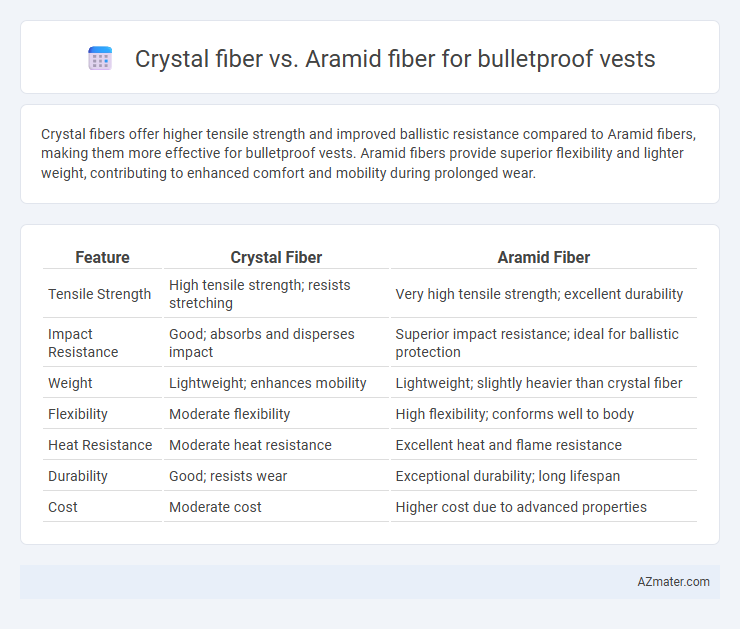Crystal fibers offer higher tensile strength and improved ballistic resistance compared to Aramid fibers, making them more effective for bulletproof vests. Aramid fibers provide superior flexibility and lighter weight, contributing to enhanced comfort and mobility during prolonged wear.
Table of Comparison
| Feature | Crystal Fiber | Aramid Fiber |
|---|---|---|
| Tensile Strength | High tensile strength; resists stretching | Very high tensile strength; excellent durability |
| Impact Resistance | Good; absorbs and disperses impact | Superior impact resistance; ideal for ballistic protection |
| Weight | Lightweight; enhances mobility | Lightweight; slightly heavier than crystal fiber |
| Flexibility | Moderate flexibility | High flexibility; conforms well to body |
| Heat Resistance | Moderate heat resistance | Excellent heat and flame resistance |
| Durability | Good; resists wear | Exceptional durability; long lifespan |
| Cost | Moderate cost | Higher cost due to advanced properties |
Introduction to Bulletproof Vest Materials
Bulletproof vests commonly utilize high-performance fibers such as crystal fiber and aramid fiber due to their exceptional strength and impact resistance. Crystal fibers, often made from ultra-high-molecular-weight polyethylene (UHMWPE), offer lightweight properties and superior ballistic protection by dissipating energy efficiently. Aramid fibers, including Kevlar and Twaron, provide excellent heat resistance and tensile strength, making them a standard choice for armor that balances flexibility and durability.
Overview of Crystal Fiber Technology
Crystal fiber technology leverages ultra-high molecular weight polyethylene (UHMWPE) polymers arranged in a tightly packed crystalline structure, offering exceptional strength-to-weight ratios far surpassing traditional fibers. Its formulation enhances ballistic resistance and energy absorption, making it an advanced alternative to aramid fibers like Kevlar in bulletproof vests. Crystal fiber's low density and high tensile strength contribute to lighter, more flexible armor without compromising protection against high-velocity projectiles.
Understanding Aramid Fiber Composition
Aramid fiber, primarily composed of long-chain synthetic polyamides, exhibits exceptional tensile strength and heat resistance, making it a preferred material in bulletproof vests for its ability to absorb and disperse ballistic energy. Crystal fiber, meanwhile, often refers to ultra-high-molecular-weight polyethylene (UHMWPE) fibers known for their lightweight and high-performance ballistic protection, though they differ structurally from the aromatic polyamide chains in aramid fibers. Understanding the molecular composition of aramid fibers highlights their robust interchain hydrogen bonding and rigid molecular backbone, which contribute to their durability and efficacy in personal armor applications.
Comparative Ballistic Protection Performance
Crystal fiber offers superior tensile strength and enhanced energy absorption, resulting in higher ballistic resistance compared to aramid fiber, which provides good impact resistance but lower stiffness. Aramid fiber excels in flexibility and weight reduction, making it ideal for lightweight ballistic vests, while crystal fiber's rigidity contributes to better multi-hit performance and penetration resistance. Studies indicate that crystal fiber composites can achieve up to 20% greater ballistic protection levels against high-velocity projectiles than standard aramid fiber materials.
Weight and Flexibility Differences
Crystal fiber offers superior lightweight properties compared to Aramid fiber, reducing the overall weight of bulletproof vests and enhancing wearer comfort during extended use. In terms of flexibility, Crystal fiber provides greater elasticity and deformation recovery, allowing for improved mobility and less restriction in movement. Aramid fiber remains durable but generally exhibits higher stiffness and weight, which can limit flexibility and increase wearer fatigue over time.
Durability and Environmental Resistance
Crystal fiber in bulletproof vests offers remarkable durability with high tensile strength and resistance to wear, maintaining integrity under prolonged stress. Aramid fiber, such as Kevlar, provides exceptional environmental resistance against heat, moisture, and UV exposure, preserving its ballistic performance in various conditions. Both fibers excel in impact resistance, but aramid fibers generally outperform crystal fibers in resisting chemical degradation and harsh environmental factors.
Comfort and Wearability Factors
Crystal fiber offers superior breathability and lightweight properties, enhancing comfort and reducing heat buildup in bulletproof vests. Aramid fiber, known for its high tensile strength and durability, tends to be thicker and less flexible, which can limit wearability and increase fatigue during extended use. Advances in crystal fiber technology provide improved moisture-wicking and flexibility, contributing to a more comfortable fit without sacrificing protection.
Cost Analysis: Crystal Fiber vs Aramid Fiber
Crystal fiber generally presents a higher initial material cost compared to aramid fiber, driven by its advanced manufacturing techniques and superior tensile properties. Aramid fiber, such as Kevlar, offers a cost-effective solution widely adopted in bulletproof vests due to its balance of performance and affordability. When considering lifecycle expenses, crystal fiber may deliver longer durability and enhanced ballistic resistance, potentially offsetting its upfront price difference over extensive field use.
Application Scenarios and Suitability
Crystal fiber offers exceptional strength-to-weight ratio and transparency, making it ideal for lightweight, high-visibility bulletproof vests in tactical and law enforcement applications where mobility and stealth are crucial. Aramid fiber, known for its high tensile strength and thermal resistance, is preferred in military and riot gear scenarios due to its superior ability to absorb and disperse ballistic energy, providing enhanced protection against high-velocity projectiles. Suitability depends on specific needs: crystal fiber favors agility and situational awareness, while aramid fiber excels in durability and multi-hit resistance under extreme conditions.
Future Trends in Bulletproof Vest Materials
Crystal fiber and aramid fiber stand at the forefront of innovation in bulletproof vest materials, with crystal fiber offering superior tensile strength and lightweight properties that enhance wearer mobility. Ongoing research is focused on combining these fibers to develop composite vests that provide enhanced ballistic resistance while reducing overall weight. Future trends emphasize nanotechnology integration and smart materials to create adaptive vests that respond dynamically to impact forces, improving protection and comfort for military and law enforcement personnel.

Infographic: Crystal fiber vs Aramid fiber for Bulletproof vest
 azmater.com
azmater.com